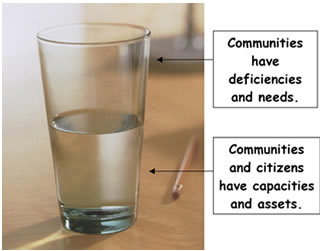
State or Province:
country:
what are your gifts and talents?:
why do you want to join abcd in action?:
The Key Principles
The Key Principles of ABCD
Asset-based community development (ABCD) is a philosophy that was developed by John P 'Jody' Kretzmann and John L McKnight from the Northwestern University in Illinois, USA. The key principles of ABCD were laid out most extensively in the book Building Communities from the Inside Out.
The first ABCD principle is to see a glass as being half full rather than half empty. The traditional approach taken by service providers when examining a community under stress or seen as being dysfunctional is to focus on what is wrong, what the community lacks, and what is failing. It's a 'glass half empty' approach. In contrast, ABCD focuses on what is right, what the community has, and what is working: a 'glass half full' approach.

This leads to the second principle: seeing assets rather than needs. ABCD uses asset maps to illustrate the strengths and skills of people, organisations, institutions and businesses. Even the most 'dysfunctional' community has assets, though these assets are often overlooked by the residents themselves as they appear dwarfed by the community's needs. Asset mapping overcomes this basic hurdle; it is the first step on the ABCD journey. 'Accounting for them in full, and enlisting them in the process of community development, is essential to the success of the process,' say Kretzmann and McKnight. Once this first step is achieved, the next is to 'join the dots' and bring these areas of asset together. By doing this the third step, mobilisation, can take place.
Compare the two diagrams below. Figure 1 is a traditional needs analysis, focusing on what is wrong and what is lacking. Figure 2 is an ABCD asset map focusing on what is right and what is an asset.

Figure 1: A traditional "needs" analysis of a community.

Figure 2: An ABCD asset map of a community.
In its Building Your Community: How to get started publication, the Central Coast Community Congress Working Party devised six tips for putting together a good asset map:
1. Explain clearly why you are developing the map, what its purpose is and what will happen with the information you gather from the map.
2. Make sure you understand why you are asking specific questions.
3. Once the ground rules are established, dont limit what people think of assets, i.e. all assets are equally important so someone with handyman skills is as valuable as someone who ownes a million-dollar business in the area.
4. There is a range of ways to create an asset map, but we've found that making the map large and visually striking, where people can add their ideas themselves, works very well.
5. Make sure that when you have developed your map, that information is available and preferably visible to the local community or group.
6. An asset map is a work in progress. Providing opportunities for people to add to it over time is as important as creating the map in the first place.
The third core principle is to develop the difference between new and old, the traditional community needs versus the ABCD approach, articulated through ABCD language.
